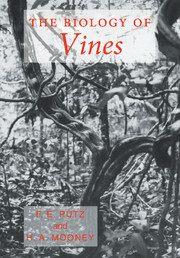Book contents
- Frontmatter
- Contents
- List of contributors
- Foreword
- Preface
- Acknowledgements
- I INTRODUCTION
- II CLIMBING MECHANICS AND STEM FORM
- III VINE PHYSIOLOGY AND DEVELOPMENT
- IV COMMUNITY ECOLOGY OF VINES
- 11 Distribution and abundance of vines in forest communities
- 12 Vines in arid and semi-arid ecosystems
- 13 Vine–host interactions
- 14 Seasonality of climbers: a review and example from Costa Rican dry forest
- 15 Breeding and dispersal systems of lianas
- V ECONOMIC IMPORTANCE OF VINES
- Taxonomic index
- General index
13 - Vine–host interactions
Published online by Cambridge University Press: 05 November 2011
- Frontmatter
- Contents
- List of contributors
- Foreword
- Preface
- Acknowledgements
- I INTRODUCTION
- II CLIMBING MECHANICS AND STEM FORM
- III VINE PHYSIOLOGY AND DEVELOPMENT
- IV COMMUNITY ECOLOGY OF VINES
- 11 Distribution and abundance of vines in forest communities
- 12 Vines in arid and semi-arid ecosystems
- 13 Vine–host interactions
- 14 Seasonality of climbers: a review and example from Costa Rican dry forest
- 15 Breeding and dispersal systems of lianas
- V ECONOMIC IMPORTANCE OF VINES
- Taxonomic index
- General index
Summary
Introduction
Some vines scramble and climb and some creep or trail. The latter do not necessarily interact with living hosts, and in fact some may not climb even when opportunities are offered (Jones & Gray, 1977). Creeping stems of vines seen in forests are most often stolons of species which have already reached the canopy, and which subsequently give rise to climbing stems which allow new territory to be colonized (e.g. Peñalosa, 1982), or young vines which have not yet located a host. The action of climbing by such stems usually involves interactions between stems and foliage of both vine and host. Once in the canopy, some vines may extend to use adjacent hosts.
This chapter considers how climbing methods differ in suitability to ascend hosts of particular sizes and shapes, and the effectiveness of anticlimber defenses.
Classification of vines
Although vines differ so much in size and form, it has been traditional to classify climbing methods into only four or five major categories. Climbers were classified by authors from Darwin (1875) and Schenck (1892, 1893) to Richards (1952) on the basis of the most obvious climbing technique. These usually include:
twining using stems, branches or petioles/petiolules
use of tendrils, including leaf tendrils
scrambling, often assisted by hooks to avoid slipping
use of adventitious roots
Each has a wide range of architectural expression, although closely related species tend to develop similar climbing attributes.
- Type
- Chapter
- Information
- The Biology of Vines , pp. 357 - 376Publisher: Cambridge University PressPrint publication year: 1992
- 7
- Cited by

